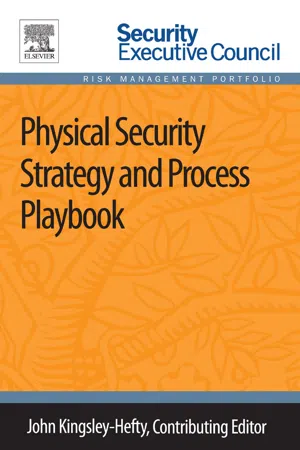
Physical Security Strategy and Process Playbook
John Kingsley-Hefty
- 160 pagine
- English
- ePUB (disponibile sull'app)
- Disponibile su iOS e Android
Physical Security Strategy and Process Playbook
John Kingsley-Hefty
Informazioni sul libro
The Physical Security Strategy and Process Playbook is a concise yet comprehensive treatment of physical security management in the business context. It can be used as an educational tool, help a security manager define security requirements, and serve as a reference for future planning.
This book is organized into six component parts around the central theme that physical security is part of sound business management. These components include an introduction to and explanation of basic physical security concepts; a description of the probable security risks for more than 40 functional areas in business; security performance guidelines along with a variety of supporting mitigation strategies; performance specifications for each of the recommended mitigation strategies; guidance on selecting, implementing, and evaluating a security system; and lists of available physical security resources.
The Physical Security Strategy and Process Playbook is an essential resource for anyone who makes security-related decisions within an organization, and can be used as an instructional guide for corporate training or in the classroom.
The Physical Security Strategy and Process Playbook is a part of Elsevier's Security Executive Council Risk Management Portfolio, a collection of real world solutions and "how-to" guidelines that equip executives, practitioners, and educators with proven information for successful security and risk management programs.
- Chapters are categorized by issues and cover the fundamental concepts of physical security up to high-level program procedures
- Emphasizes performance guidelines (rather than standards) that describe the basic levels of performance to be achieved
- Discusses the typical security risks that occur in more than 40 functional areas of an organization, along with security performance guidelines and specifications for each
- Covers the selection, implementation, and evaluation of a robust security system
Domande frequenti
Informazioni
Physical Security Concepts
Keywords
1.1 Before you Begin
1.1.1 What are your Security Goals?
1.2 Assessing the Needs of your Business
1.2.1 Elements of Security
1.2.1.1 Element 1: Probability
1.2.1.2 Element 2: Criticality
1.2.1.3 Element 3: Vulnerability
1.2.2 Combining the Three Elements of Security to Arrive at an Assessment of Risk
Indice dei contenuti
- Cover image
- Title page
- Table of Contents
- Copyright
- Executive Summary
- Introduction
- Chapter 1. Physical Security Concepts
- Chapter 2. Functional Areas and Security Risks
- Chapter 3. Security Performance Guidelines and Options
- Chapter 4. Performance Specifications
- Chapter 5. Systems Implementation and Evaluation
- Chapter 6. Physical Security Resources
- About the Contributing Editor
- About Elsevier’s Security Executive Council Risk Management Portfolio